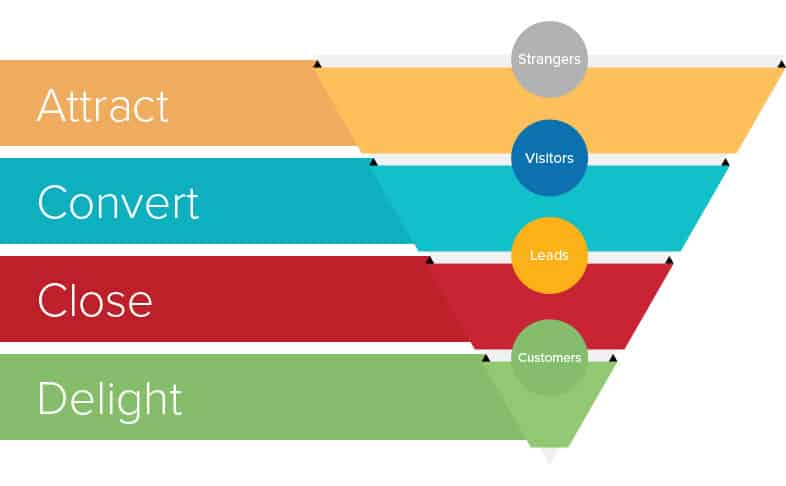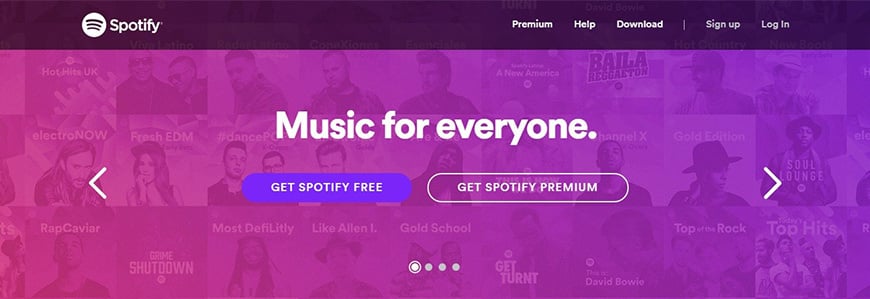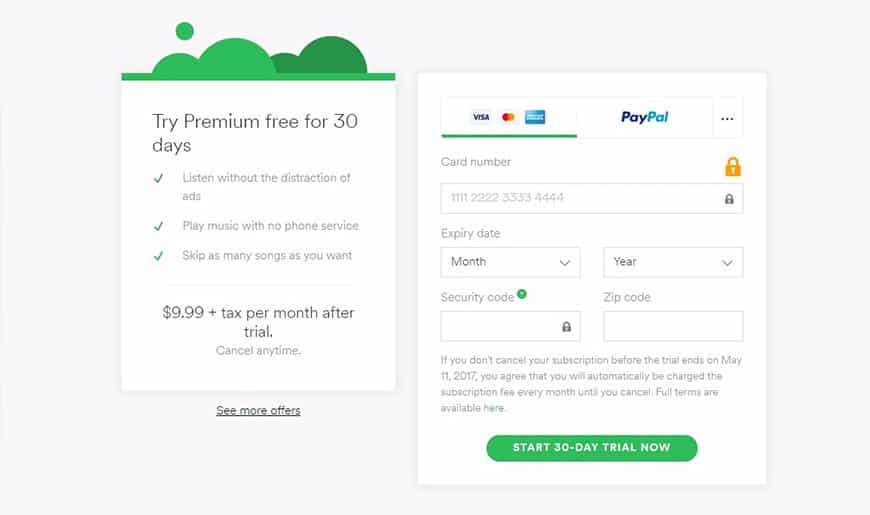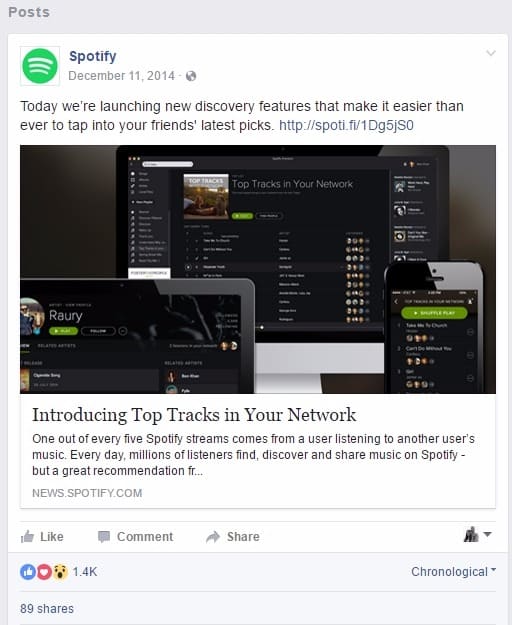One of the most common questions we get asked by clients is, “What’s the most effective marketing technique that’ll get me leads?” Unfortunately, the question is impossible to answer. It assumes there is one technique that will turn someone who’s never heard of your business into a paying customer. We wish it were that easy!
Even if you spend thousands of dollars to drive qualified traffic to your website, it’s unlikely these visitors will be ready to buy your product or service right away. Rather than looking for the one marketing technique that will get you customers, instead think about how your marketing and sales efforts can work together to put your prospects on the right path to learning about and then buying from your business. A sales funnel can accomplish just that.
What is a sales funnel?
The sales funnel concept illustrates the journey your prospects go through on their way to becoming customers. While you may market your products or services to thousands of people, only a small percentage will provide contact information and become leads. Of those leads, only a fraction will decide to purchase.

By now you might have guessed why it’s called a sales funnel. You have to funnel prospects through in order to close that amazing new client. We create different types of content for our clients to target potential customers who are at the top, middle, or bottom of the funnel (known as TOFU, MOFU, and BOFU). To break this down even further, let’s separate the funnel into the following stages.
- Attract: Marketing and advertising that bring visitors to your website
- Convert: Offers that inspire visitors to share their contact information
- Close: Efforts that encourage leads to close and become paying customers
- Delight: Quality service that keeps your customers happy and inspires referrals
The ideal scenario
To illustrate this process, let’s assume that you’re looking for a music subscription service.
Attract
You head over to Google and search for “streaming music.” In the search results, you see “Spotify: Music for everyone” so you click on the link and get directed to the Spotify homepage. You may have been attracted by name-brand recognition, or perhaps the tagline “Music for everyone” resonates with you, or maybe you clicked simply because it’s the first organic search result.

Convert
You scan through the homepage and notice the big blue button that says “Get Spotify Free.” You enter your name and email address and sign up for an account. Before you know it, you’re enjoying your favorite tunes!

Close
A couple of days later, you receive an email from Spotify that describes the benefits of Spotify Premium (no ads, offline listening, etc.). The free service has been great, but the ads are a bit annoying so you enter your credit card details and subscribe to the premium account.

Delight
You enjoy Spotify so much that you tell your friends about it and encourage them to create free accounts. You effectively become a promoter of the service and you continue to engage with other subscribers through shared playlists and social media.

In this example, Spotify attracted you to their service through a mix of SEO and brand recognition. Their offer of a free subscription converted you from an anonymous website visitor into a lead and the email helped close the deal. But it didn’t stop there. The high quality of service and social sharing options inspired you to refer friends so the cycle could continue.
The reason we call this the ideal scenario is because it assumes that you found Spotify from your Google search for “streaming music.” In reality, Spotify worked to attract you to their service through YouTube ads, social media advertising, and other marketing channels. After all these efforts, the Google search was just the last piece that pushed you over the edge.
While your company is likely very different from Spotify, the principles remain the same. You need to do all you can to attract qualified traffic to your website, convert visitors to leads, close your leads, and delight your clients so they stay with you and help promote your products or services.
10 Tips for improving your sales funnel
Now that we understand what the sales funnel is and why it’s so important, let’s look at some ways to make it as effective as possible.
- Add new blog content to your website on a regular basis
- Use other marketing channels to attract visitors
- Analyze the effectiveness of your marketing campaigns
- Listen to your prospects and customers and adapt your website accordingly
- Include more than one CTA (call to action) on your website
- Retarget website visitors who don’t convert the first time
- Become an authority in your industry and/or region
- Nurture your prospects
- Add an incentive to your referral program
- Take action now!
Content is king, and a blog is a great place to organize all of your great content. Writing useful articles can improve your SEO and help you engage with your current clients.
Our most successful clients are using a mix of multiple marketing channels, including off-site SEO, local event hosting, and LinkedIn outreach to their ideal customers. Your specific channels may differ depending on your industry, but it’s best to not put all your eggs in one basket, as it is natural for channels to go up and down over time in terms of effectiveness.
In order to learn what marketing channels are most effective for your business, analyze your website traffic and inbound phone calls. This data will help you make educated decisions so you are constantly improving instead of trying one thing after another and hoping for the best.
If your clients and prospects are asking questions related to your products or services, consider answering these questions in a blog article. Chances are that others have similar questions and adding the answers to your site may attract new visitors.
Your website visitors will be at different stages of the customer journey. Some might be ready to call or email, while others might be researching. Make sure to include offers like free eBooks or white papers to capture names and email addresses for those who aren’t quite ready to talk to your sales team.
You won’t be able to capture lead information for all of your website visitors, but that doesn’t mean you should give up on the visitors who don’t convert. Consider running a retargeting campaign so you can display advertisements that will display only to people who visited your website. This will give you a chance to draw them back in.
If you’re known for being an industry expert, you’ll have prospects seeking you out rather than the other way around. Consider planning “lunch and learn” sessions or organizing webinars on a regular basis. As your brand recognition grows, you may even attract inbound links to your site, which will benefit your SEO.
Don’t give up on your leads. If they provided their email or phone number, it’s likely that they have an interest in your products or services but are just not ready to buy immediately. You may need to nurture them by sending monthly email newsletters, targeted email broadcasts, or email drip campaigns.
If you have a referral program, make sure you’re promoting it to your clients. You should have a page on your website that explains your referral program, but you can’t expect your clients to hunt for it. Make sure to remind them in your email newsletter or email signature.
The first step to improving your sales funnel is to begin connecting with people ASAP. Remember, this is a long-term project: If you wait until next month or next quarter, you likely won’t see results until next year. That said, you don’t have to take on everything at once, but you should create a game plan with specific milestones to ensure you start making progress.
Taking action to improve your sales funnel
A good first step is to simply list all your current marketing efforts, then categorize them into the four sales funnel stages we talked about earlier (attract, convert, close, delight). Once you have this visualized, try to spot any gaps. These are areas for improvement, and you can categorize them in order of priority.
Take it one step further and divide your marketing improvements into stages. Perhaps the first stage is to enhance the conversion path on your website by offering a free eBook or free consultation to visitors. Once you feel confident that you can capture lead information, you might be ready to invest in additional marketing efforts to attract new visitors to your site.